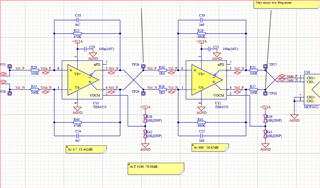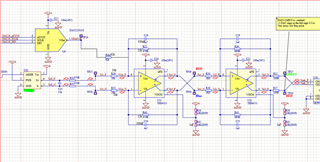Other Parts Discussed in Thread: TINA-TI
Tool/software:
Hello,
The THS2551 datasheet, p38 Section 9.4 recommends connecting a decoupling capacitor to the Vocm pin.
What would be a reasonable value for this?
My circuit uses 3.3V single rail supply and the Vocm is currently floating at ~1.6V.
The signals I am trying to amplify are low frequency (<20Hz).
I currently have a 2 stage amplifier using this device where stage 1 has Rf = 470k, Ri = 100k Av = 4.7 and stage 2 has Rf = 680k, Ri = 1k0 Av= 680
The input signals are in the uV to nV range and I am currently trying to reduce noise on the amplifier output.

Thank you for any suggestions.
Best regards
B


